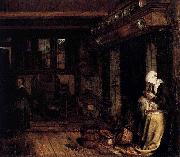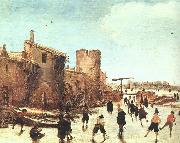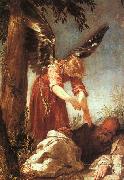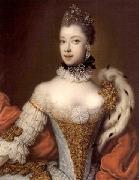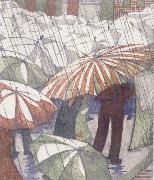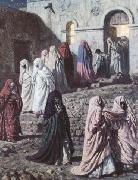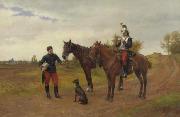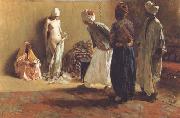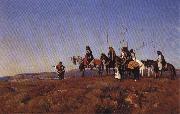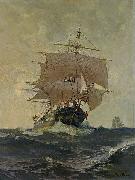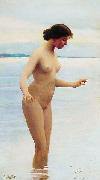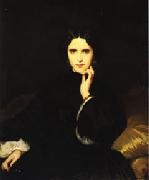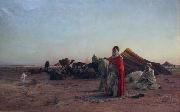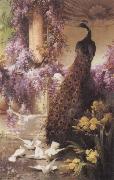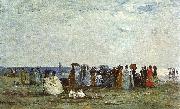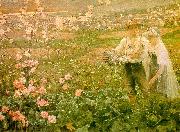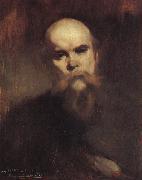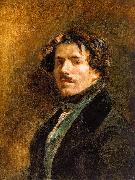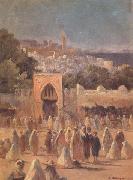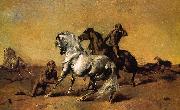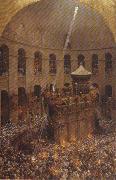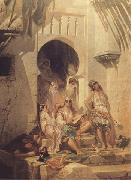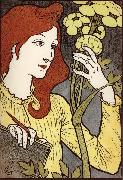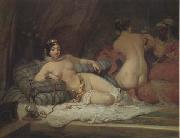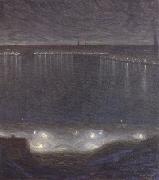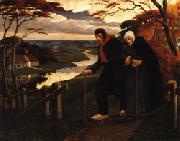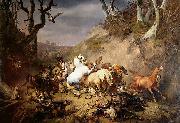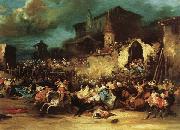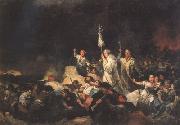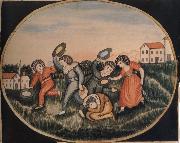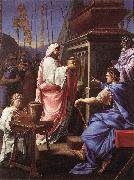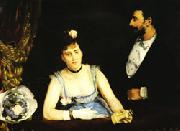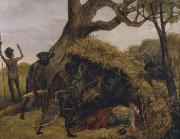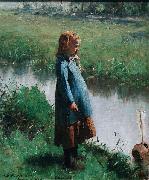|
|
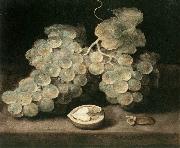 |
ES, Jacob van
|
|
Flemish painter (b. ca. 1596, Antwerpen, d. 1666, Antwerpen) |
|
|
|
|
|
|
|
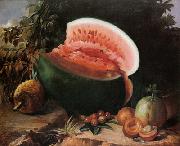 |
Estevao Silva
|
|
Estevao Roberto da Silva (Rio de Janeiro, c. 1844 - idem, 9 de novembro de 1891) foi um importante pintor e professor brasileiro da segunda metade do seculo XIX. Primeiro pintor negro de destaque formado pela Academia Imperial de Belas Artes, notabilizou-se por suas naturezas-mortas, sendo considerado um dos maiores expoentes da arte brasileira no genero. |
|
|
|
|
|
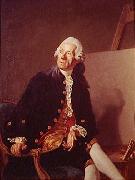 |
Etienne Aubry
|
|
Etienne Aubry, who was born at Versailles in 1746, studied under J. A. Silvestre and Joseph Vien, and soon became noted for his portraits and genre subjects. He exhibited several works of great merit at the Salon; but his life was cut short in its prime in 1781, in which year he had exhibited the 'Parting of Coriolanus from his Wife.' |
|
|
|
|
|
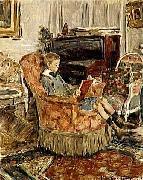 |
Etienne Moreau-Nelaton
|
|
Adolphe Etienne Auguste Moreau-Nelaton (2 December 1859, Paris- 25 April 1927, Paris) was a French painter, art collector and art historian. His large collection is today held in its entirety by National French museums.
Moreau-Nelaton's family's art collecting began with his grandfather Adolphe Moreau (1800-59). As a stockbroker he possessed ample capital with which to buy the work of artists with whom he was personally acquainted, including Eugene Delacroix and Alexandre-Gabriel Decamps. Moreau-Nelaton's father, who was also named Adolphe Moureau (1827-82), was a high government official and led the railroad company Chemins de fer de l'Est. In 1856 he married the ceramic artist Camille Nelaton (1840-97), with whom he further expanded the family's collection. |
|
|
|
|
|
 |
Ettore Tito
|
|
(17 December 1859-26 June 1941) was an Italian artist particularly known for his paintings of contemporary life and landscapes in Venice and the surrounding region. He trained at the Accademia di Belle Arti in Venice and from 1894 to 1927 was the Professor of Painting there. Tito exhibited widely and was awarded the Grand Prize in painting at the 1915 Panama CPacific International Exposition in San Francisco. In 1926 he was made a member of the Royal Academy of Italy. Tito was born in Castellammare di Stabia in the province of Naples and died in Venice, the city which was his home for most of his life. |
|
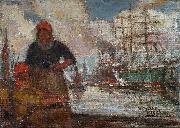 |
Eugeen Van Mieghem
|
|
(1 October 1875-1930) was a Belgian artist born in the port of Antwerp. As a boy Van Mieghem was confronted with the harsh reality of life at the waterfront.
Even at primary school he showed a talent for drawing. He was introduced to the work of Vincent van Gogh, Georges Seurat, Camille Pissarro, Henri de Toulouse-Lautrec and others at an exhibition organised by Flemish painter and architect Henry van de Velde at the Antwerp Academy around 1892. He attended the Antwerp Academy but was sent from school because his conservative teachers disliked his subject matter and his free, spontaneous way with it. He threw his lot in with progressive political and cultural movements, and joined an anarchist group. By the early 1900s was recognized as one of the most promising young artists of the Antwerp school. He would never renounce his idealism. He became the artist of the typical harbour folk: sack porters, sack makers, emigrants, dockers, bargees, and tramps.
Van Mieghem had his first taste of real success at La Libre Esthetique in Brussels, where his pastels and drawings hung alongside works by French impressionists such as Claude Monet, Paul Cezanne, Camille Pissarro, Jean Renoir and Edouard Vuillard.
|
|
|
|
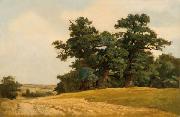 |
Eugen Ducker
|
|
was a romanticist Baltic German painter.
He was born in Kuressaare, Estonia, on 29 January 1841 in the Julian calendar (10 February 1841 according to the Gregorian calendar) and died on 6 December 1916 in Dusseldorf, where he developed almost all his career. A notable student of his was the Norwegian landscape painter Adelsteen Normann who studied with Ducker from 1869 to 1872. |
|
|
|
|
|
|
|
|
|
|
|
|
|
|
|
|
|
|
|
|
|
|
|
|
|
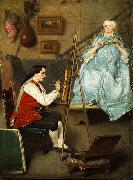 |
Eugene Fichel
|
|
(30 August 1826 Paris - 2 February 1895 Paris) was a French painter.
He entered the École des Beaux-Arts in 1844 and became a pupil of Hippolyte Delaroche, but painted very much more under the inspiration of Jean-Louis-Ernest Meissonier, whose exquisite handling is suggested in numerous small canvases of his which by their refined technique and vivid action recall the characteristic intensity and directness of composition which belong to the painter of eFriedland.e Along with great care in finish, Fichel's canvases also exhibit an archæological exactness, and a kind of delicate humor. His first work of importance was exhibited in 1850, eHarvey Demonstrating the Circulation of the Blood to Charles I.e He was a chevalier of the Legion of Honor and, in 1857, received a medal for his painting in the Salon of that year. He exhibited a canvas every year at the Salon, up to a few years before his death.
|
|
|
|
|
|
|
|
|
|
|
|
|
|
|
|
|
|
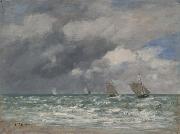 |
Eugene Louis Boudin
|
|
(12 July 1824 - 8 August 1898) was one of the first French landscape painters to paint outdoors.
Boudin was a marine painter, and expert in the rendering of all that goes upon the sea and along its shores. His pastels, summary and economic, garnered the splendid eulogy of Baudelaire, and Corot who, gazing at his pictures, said to him, "You are the master of the sky."
Born at Honfleur, France, he worked in a small art shop where Claude Monet displayed his art work Le Havre and Honfleur across the estuary of the Seine. But before old age came on him, Boudin's father abandoned seafaring, and his son gave it up too, having no real vocation for it, though he preserved to his last days much of a sailor's character, frankness, accessibility, and open-heartedness.
In 1835, his family moved to Le Havre, where his father established himself as stationer and frame-maker. He began work the next year as an assistant in a stationery and framing store before opening his own small shop. There he came into contact with artists working in the area and exhibited in his shop the paintings of Constant Troyon and Jean-François Millet, who, along with Jean-Baptiste Isabey and Thomas Couture whom he met during this time, encouraged young Boudin to follow an artistic career. At the age of 22 he abandoned the world of commerce, started painting full-time, and traveled to Paris the following year and then through Flanders. In 1850 he earned a scholarship that enabled him to move to Paris, although he often returned to paint in Normandy and, from 1855, made regular trips to Brittany.
The Beach at Villerville, 1864. Eugene Boudin. Oil on canvas. National Gallery of Art, Washington DC. (Zoomview)
Rivage de Pontrieux, Cotes-du-Nord. 1874. Eugene Boudin.
Landscape with Sunset. 1880-1890. Watercolour. Musee d'Orsay, Paris
Berck, Fishermen at Low TideDutch 17th century masters profoundly influenced him, and on meeting the Dutch painter Johan Jongkind, who already made his mark in French artistic circles, Boudin was advised by his new friend to paint outdoors (en plein air). He also worked with Troyon and Isabey, and in 1859 met Gustave Courbet who introduced him to Charles Baudelaire, the first critic to draw Boudines talents to public attention when the artist made his debut at the 1859 Paris Salon.
In 1856/57 Boudin met the young Claude Monet who spent several months working with Boudin in his studio. The two remained lifelong friends and Monet later paid tribute to Boudines early influence. Boudin joined Monet and his young friends in the first Impressionist exhibition in 1874, but never considered himself a radical or innovator.
Boudines growing reputation enabled him to travel extensively in the 1870s. He visited Belgium, the Netherlands, and southern France, and from 1892 to 1895 made regular trips to Venice. He continued to exhibit at the Paris Salons, receiving a third place medal at the Paris Salon of 1881, and a gold medal at the 1889 Exposition Universelle. In 1892 Boudin was made a knight of the Legion d'honneur, a somewhat tardy recognition of his talents and influence on the art of his contemporaries.
Late in his life he returned to the south of France as a refuge from ill-health, and recognizing soon that the relief it could give him was almost spent, he returned to his home at Deauville, to die within sight of Channel waters and under Channel skies.
|
|
|
|
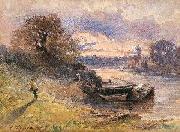 |
Eugenio Gignous
|
|
(Milan, 1850 - Stresa (Verbania), 1906) was an Italian painter.
The son of a silk merchant from Lyon, Gignous displayed a precocious talent for painting and enrolled at the Brera Academy of Fine Arts in 1864, attending the courses on landscape taught by Luigi Riccardi and then Gaetano Fasanotti. He came into contact with the Milanese Scapigliatura movement when still very young and formed a close friendship with Tranquillo Cremona. He began to focus exclusively on landscape in the 1870s, experimenting with painting en plein air and producing views of the Lombard and Piedmontese countryside that he showed at all the major national exhibitions. The late 1870s saw a more naturalistic approach to landscape painting under the influence of Filippo Carcano, with whom Gignous went to paint on Lake Maggiore in 1879, thus inaugurating a thematic repertoire devoted primarily to views of the Verbano, Mottarone and Val deOssola. Some biographical notes written by the artistes wife Matilde would appear to bear out the hypothesis of a trip to Paris in the company of Carcano in 1878 and attest to friendship with Vincenzo Vela, who was apparently his host on numerous occasions in Ligornetto. A recognised leader of the Lombard school of painting, he lived in Stresa and on the coast of Liguria from 1887 to 1906, his year of his death, with long stays in Venice. The Venice Biennale held a retrospective exhibition of his work in 1907.
|
|
|
|
|
|
|
|
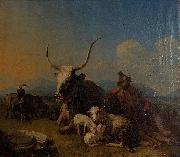 |
Eugne Joseph Verboeckhoven
|
|
(1790-1881), Belgian painter, was born at Warneton in West Flanders, and received instruction in drawing and modelling from his father, the sculptor Barthelemy Verboeckhoven. Subsequently he settled in Brussels and devoted himself almost exclusively to animal subjects.
Shepherd with animals in the countryside
attributed to Eugene Verboeckhoven - private collectionHis paintings of sheep, of horses and of cattle in landscape, somewhat after the manner of Paulus Potter, brought him universal fame, and were eagerly sought for by collectors. Precise and careful finish is the chief quality of his art, which is entirely objective and lacking in inspiration. Verboeckhoven visited England in 1826, Germany in 1828, and France and Italy in 1841, and died at Brussels in 1881. He was a member of the academies of Brussels, Ghent, Antwerp, St. Petersburg and Amsterdam. Examples of his art are to be found in nearly all the important galleries of Europe and the United States, notably in Brussels, Antwerp, Amsterdam, Hamburg, Berlin, Munich, New York, Boston and Washington D.C.. His long life and ceaseless industry account for the enormous number of his pictures in public and private collections and in the art market. In addition to his painted work he executed some fifty etched plates of similar subjects.
|
|
|
|
|
|
|
|
|
|
|
|
|








